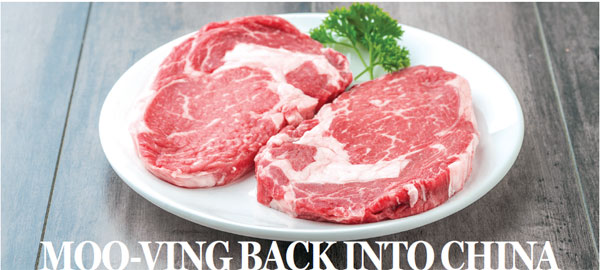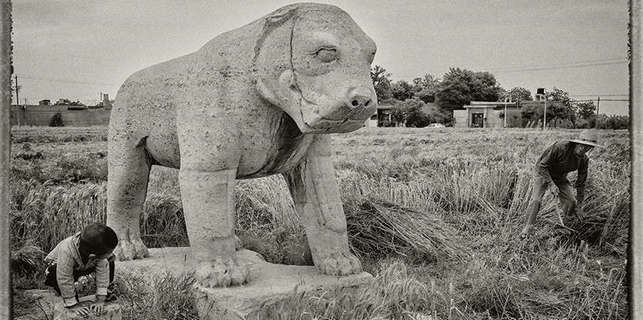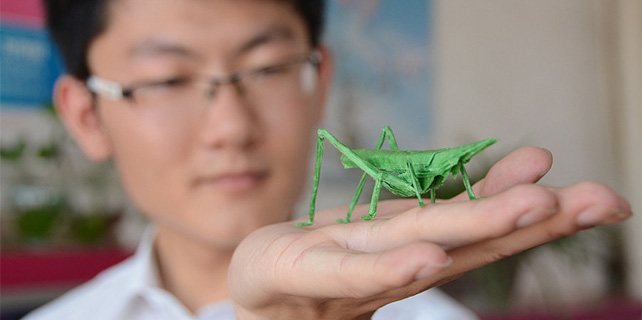Moo-ving back into China

US beef returns to Chinese dining tables where appetite for the meat has been growing rapidly, but its prohibitive pricing might hamper its efforts to gain market share in a country where many people don't know the difference between a ribeye and a sirloin
Liang Jiahao first encountered beef in a local chain restaurant called Haoxianglai, which literally means "really wish to come" in Chinese.
The meal was considered a luxury. Liang, who was then a fifth grader, spent 10 times his weekly allowance on a steak that cost 200 yuan ($29.4). But it was money well-spent.
"It was the first time I was asked how I wanted my steak done. That completely blew my mind. I never knew there was a scale for the doneness of meat. The only question my mom or grandma would ask me regarding meat is whether I wanted my pork fried or braised," quipped the 26-year-old Shanghai native.
Today, as the founder and owner of My Butchery, a trendy butchery cum deli in Shanghai, Liang is usually the one asking his customers questions about their choices of meat. He said he opened the shop after noticing a gap in the market between overpriced offerings from import supermarkets and the greasy counters at local markets.
Soon, the butchery will expand its offerings by including a new product: the eagerly-awaited US beef.
Exports of US beef to China resumed in July under a new trade deal that followed the meeting of Chinese President Xi Jinping and US President Donald Trump in Florida in April. US beef had previously been absent in the Chinese market since 2003 when China banned all beef imports from the US following the outbreak of bovine spongiform encephalopathy, more commonly known as mad cow disease.
As part of the 100-day action plan for Sino-US economic cooperation which was unveiled in mid-May, an initial batch of five tons of beef arrived in China just before Independence Day on July 4 in the US, according to the US Meat Export Federation.
"The reinstitution of US beef to China is huge. I can never overestimate how important it is. Because of the growing middle class and the consumption of good and tasty protein, I think US producers can supply the products in demand here," Sonny Perdue, the US Secretary of Agriculture, told China Daily USA on July 1.
While Perdue declined to forecast the volume or value of US beef entering China in the coming years, he noted that US beef producers have been looking forward to satisfying the appetite of Chinese consumers.
"As you know, there has been a boom in the growth of beef in China over the last four or five years and I am convinced that once Chinese consumers taste US beef, this growth will be 10 or 20 times larger in the coming years," he added.
A massive appetite for beef
Per-capita consumption of beef in China, where pork is the most popular choice of meat, has doubled from 2.8 kilograms per year at the beginning of the century to 5.45 kg in 2015.
While this amount is still lower than the global average of 6.6 kg, the US Agriculture Department has projected that China will this year overtake the European Union as the world's second largest consumption market for beef after the US where per-capita consumption is 25.27 kg.
Last year, people in China consumed 8 million tons of beef worth a market value of 360 million yuan, according to China's Ministry of Agriculture. Domestic beef production rose to 7.17 million tons in 2016, a 2.4 percent year-on-year increase. A demand-supply gap of 830,000 tons is still waiting to be filled.
Before the implementation of the ban, US beef had a significant market share in China. According to The Observatory of Economic Complexity, US beef accounted for 44 percent of China's total beef imports in 1999. In recent years, Australia and Brazil have become the main sources of imported beef in China, which is currently the world's second largest beef importer after the US.
Retailers and restaurateurs said that the return of US beef is unlikely to reshape the current landscape or oversaturate the market.
"The market is too large and demand is still outnumbering supply. Besides, its high price has restricted it to a very niche group of consumers," said Yang Yiyi, vice president of Yiguo, a fresh produce e-commerce platform headquartered in Shanghai.
Backed by Alibaba Group Holding Ltd, Yiguo is one of the first two domestic e-commerce retailers to sell US beef in China. The other is Womai.com, an online platform that is run by the country's largest food trader China National Cereals, Oils and Foodstuffs Corp.
According to the final trade deal agreed by the Chinese and US governments in May, US beef exported to China must come from cattle no older than 30 months and be free of any hormones, ractopamine and other chemicals prohibited by Chinese law.
Xu Shangzhong, chief of the China Cattle Industry Association, pointed out that the amount of US beef that meets this stringent criteria accounts for less than 10 percent of the total production in the US.
















